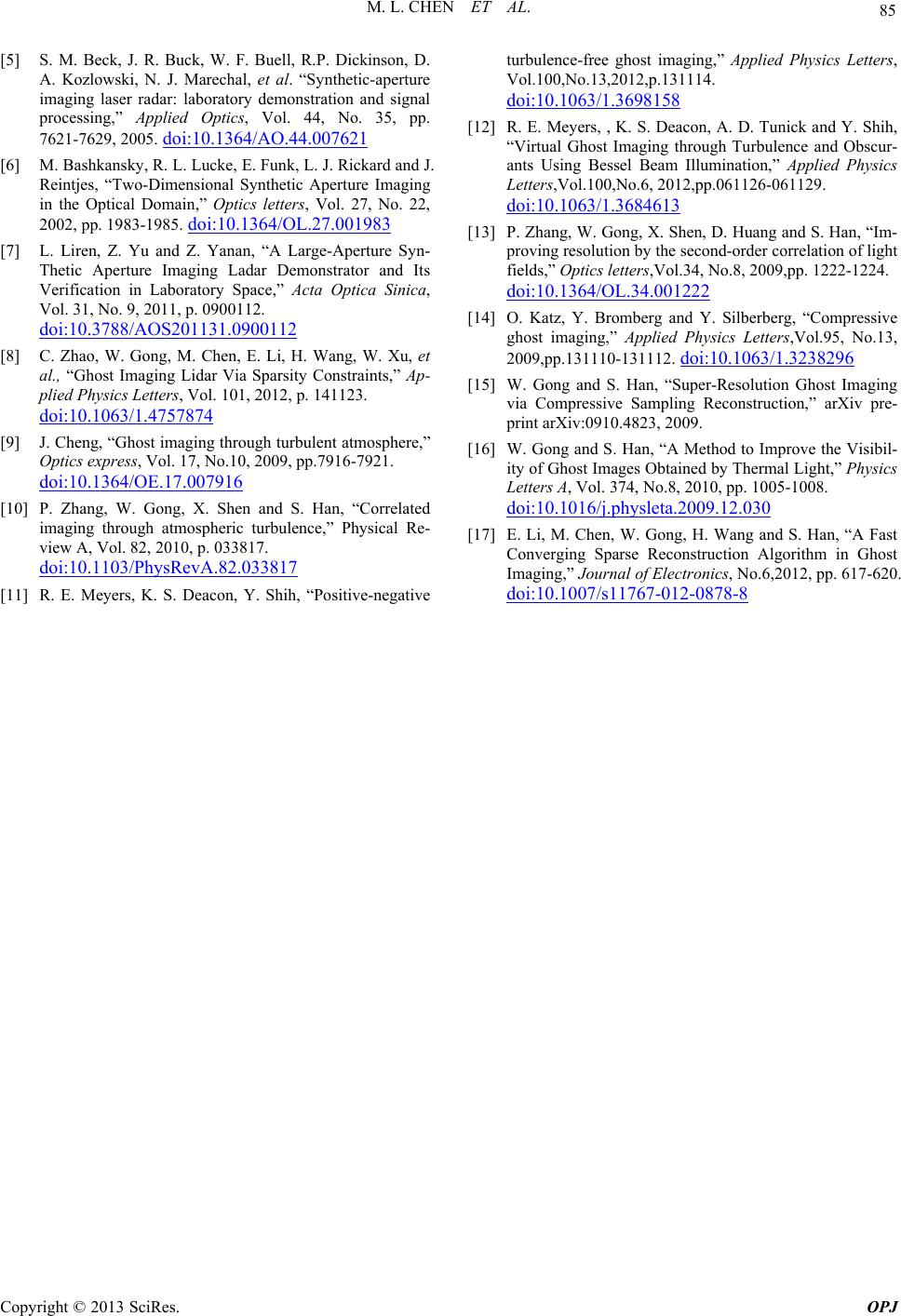
M. L. CHEN ET AL.
Copyright © 2013 SciRes. OPJ
85
[5] S. M. Beck, J. R. Buck, W. F. Buell, R.P. Dickinson, D.
A. Kozlowski, N. J. Marechal, et al. “Synthetic-aperture
imaging laser radar: laboratory demonstration and signal
processing,” Applied Optics, Vol. 44, No. 35, pp.
7621-7629, 2005. doi:10.1364/AO.44.007621
[6] M. Bashkansky, R. L. Lucke, E. Funk, L. J. Rickard and J.
Reintjes, “Two-Dimensional Synthetic Aperture Imaging
in the Optical Domain,” Optics letters, Vol. 27, No. 22,
2002, pp. 1983-1985. doi:10.1364/OL.27.001983
[7] L. Liren, Z. Yu and Z. Yanan, “A Large-Aperture Syn-
Thetic Aperture Imaging Ladar Demonstrator and Its
Verification in Laboratory Space,” Acta Optica Sinica,
Vol. 31, No. 9, 2011, p. 0900112.
doi:10.3788/AOS201131 .0900112
[8] C. Zhao, W. Gong, M. Chen, E. Li, H. Wang, W. Xu, et
al., “Ghost Imaging Lidar Via Sparsity Constraints,” Ap-
plied Physics Letters, Vol. 101, 2012, p. 141123.
doi:10.1063/1.4757874
[9] J. Cheng, “Ghost imaging through turbulent atmosphere,”
Optics express, Vol. 17, No.10, 2009, pp.7916-7921.
doi:10.1364/OE.17.007916
[10] P. Zhang, W. Gong, X. Shen and S. Han, “Correlated
imaging through atmospheric turbulence,” Physical Re-
view A, Vol. 82, 2010, p. 033817.
doi:10.1103/PhysRevA.82.033817
[11] R. E. Meyers, K. S. Deacon, Y. Shih, “Positive-negative
turbulence-free ghost imaging,” Applied Physics Letters,
Vol.100,No.13,2012,p.131114.
doi:10.1063/1.3698158
[12] R. E. Meyers, , K. S. Deacon, A. D. Tunic k and Y. Shih,
“Virtual Ghost Imaging through Turbulence and Obscur-
ants Using Bessel Beam Illumination,” Applied Physics
Letters,Vol.100,No.6, 2012,pp.061126-061129.
doi:10.1063/1.3684613
[13] P. Zhang, W. Gong, X. Shen, D. Huang and S. Han, “Im-
proving resolution by the second-order correlation of light
fields,” Optics letters,Vol.34, No.8, 2009,pp. 1222-1224.
doi:10.1364/OL.34.001222
[14] O. Katz, Y. Bromberg and Y. Silberberg, “Compressive
ghost imaging,” Applied Physics Letters,Vol.95, No.13,
2009,pp.131110-131112. doi:10.1063/1.3238296
[15] W. Gong and S. Han, “Super-Resolution Ghost Imaging
via Compressive Sampling Reconstruction,” arXiv pre-
print arXiv:0910.4823, 2009.
[16] W. Gong and S. Han, “A Method to Improve the Visibil-
ity of Ghost Images Obtained by Thermal Light,” Physics
Letters A, Vol. 374, No.8, 2010, pp. 1005-1008.
doi:10.1016/j.physleta.2009.12.030
[17] E. Li, M. Chen, W. Gong, H. Wang and S. Han, “A Fast
Converging Sparse Reconstruction Algorithm in Ghost
Imaging,” Journal of Electronics, No.6,2012, pp. 617-620.
doi:10.1007/s11767-012-0878-8